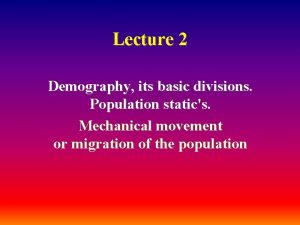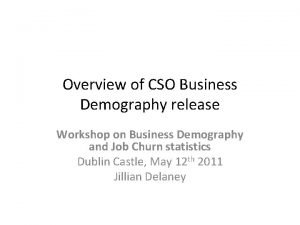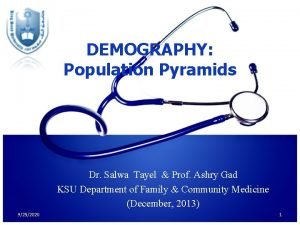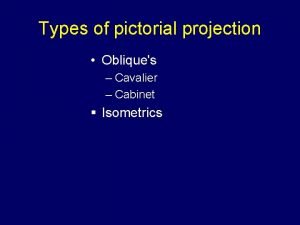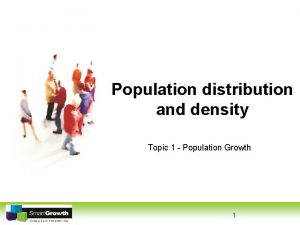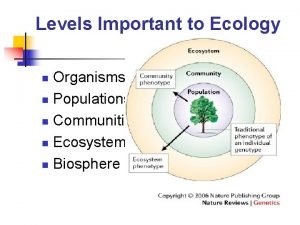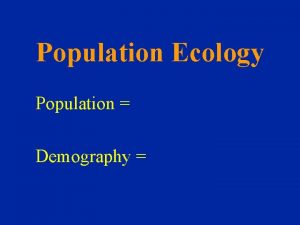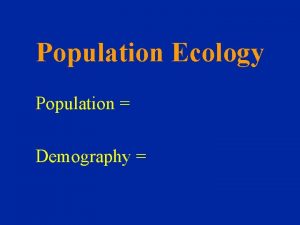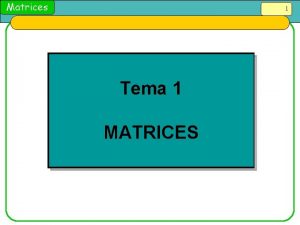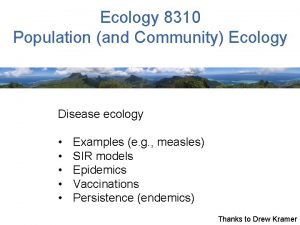Population Ecology Demography Leslie Matrices and Population Projection



































- Slides: 35

Population Ecology & Demography; Leslie Matrices and Population Projection Methods Introduction to linking demography, population growth and extinction due to climate warming

What is Population Ecology? • Goal is to understand factors and processes that govern abundance • Two types of Factors – Proximate – Ultimate • Two general processes – Extrinsic (Density Independent) – Intrinsic (Density Dependent)

Population Descriptions • Population Growth • Population Regulation

A Simple Model of Population Growth

Population Growth What is the rate of change in a population over time? A model of population growth for species without age-structure

Project Population Size assumes finite rate of increase (population growth rate) is invariant over time

Growth in Age-Structured Populations Offspring and adults coexist age-specific contribution to recruitment and mortality

Data Required for estimating Population Growth Rate Cohort Analysis Longitudinal Analysis

The Life Table • A compendium of age-specific survival • Age-specific birth • Requires: – known age • cohort (longitudinal) • cross-sectional

A life table Age nx lx Sx mx l x mx 0 1000 1. 0 0. 5 0. 0 1 500 0. 5 0. 2 0. 0 2 100 0. 1 0. 5 5. 0 0. 5 3 50 0. 05 0. 1 9. 0 4. 5 4 5 0. 0 - - - nx = probability a newborn attains age x lx = probability a newborn attains age x sx = age-specific survival, i. e. , survival between age x x+1 mx = Number of female progeny per female

Population Parameters Net Reproductive Rate – R 0 Average lifetime number of offspring produced per female Cohort Generation Time - G

Population Growth Rate - r intrinsic rate of increase - r

A Population Model F 4 F 3 1 0 s 0 2 s 1 3 s 2 4 s 4

Population Projection for Age-structured Populations The population size at time t = sum of individuals in each age class

Estimate population growth in Age Structured Populations 2 Components – Birth and Death Birth: Death:

Matrix Population Models Hal Caswell

Population Projection Matrix • How to predict population growth rate for age-structured populations? • Need to link age estimate of λ structure with

Leslie Matrix

Elements of Leslie Matrix (L) Fx – Age-specific Fecundity × age-specific survival Fx = Sx mx+1 Sx –Age-specific Survival

How does the Leslie Matrix estimate Population Growth?

Population Projection

Population Projection

Assumptions • Individuals can be aged reliably • No age-effects in vital rates • Vital rates are constant – Constant environment – No density dependence – stochastic Leslie Matrices possible • Sex ratio at birth is 1: 1 – i. e. , male and female vital rates are congruent

Advantages of Leslie Matrix • Stable-age distribution not assumed • Sensitivity analyses – – can identify main age-specific vital rates that affect abundance and age structure • Modify the analyses to include densitydependence • Derive finite rate of population change (λ) and SAD

Disadvantage of Leslie Matrix • See assumptions • Age data may not be available – can use stage-based Lefkovitch Matrix • Fecundity data may not be available for all ages

Eigen. Analysis of L • Eigenvalues – – dominant = population growth rate • asymptotic growth rate at Stable Age Distribution • Stable Age Structure – right eigenvector • Reproductive Value – left eigenvector

Other Statistics • Sensitivities – how λ varies with a change in matrix elements • absolute changes in matrix elements • Elasticities – how λ varies with a change in a vital rate holding other rates constant – • Damping ratio – rate population approaches equilibrium - SAD

Relevance of Population Projection Matrices for modeling extinction due to Climate Warming from Funk & Mills 2003. Biological Conservation 111: 205 - 214

Consequences of Climate Warming • Rising temperatures: – Survivorship • Reduce Adult Survivorship • Reduce Juvenile Survivorship – Smaller Body Size • Higher Metabolic Rate – More energy diverted to maintenance, less to growth • Change in Precipitation – Lower food availability

Results • ΔNx, t decline – Reduction in recruitment – Reduced survivorship

Simulations • Using predicted responses one can simulate expected population dynamics. • Modified PVA – Population Viability Analysis

Population Projection Methods in R • Available Packages – popbio (Stubben, Milligan, Nantel 2005) – primer (Stevens 2009) – popdemo (Stott et al. 2009)

Population Projection using Excel • Pop. Tools – www. poptools. org – add-in for excel

Main Functions (popbio) • Estimate Population Growth Rate λ – lambda(A) • Estimate Sensitivity, Elasticity, Damping Ratio – sensitivity(A) – elasticity(A) – damping. ratio(A) • Full analysis of Leslie Matrix – eigen. analysis(A)

Population Projection Methods • Population Projection – pop. projection(A, n, interations)
 Population demography definition
Population demography definition Population ecology section 1 population dynamics answer key
Population ecology section 1 population dynamics answer key Population ecology section 1 population dynamics
Population ecology section 1 population dynamics Population ecology section 1 population dynamics
Population ecology section 1 population dynamics Chapter 4 section 1 population dynamics study guide
Chapter 4 section 1 population dynamics study guide Leslie matrices
Leslie matrices Static demography
Static demography Cso business demography
Cso business demography Elements of demography
Elements of demography Demography ap human geography
Demography ap human geography Sources of demography ppt
Sources of demography ppt Components of demography
Components of demography Acronym antonym
Acronym antonym System of orthographic projection
System of orthographic projection Pictorial projection types
Pictorial projection types Isometric projection in c
Isometric projection in c Dnt 111
Dnt 111 Logistic growth ecology definition
Logistic growth ecology definition Logistic and exponential growth
Logistic and exponential growth 52
52 Ecosystem vs community
Ecosystem vs community Concept 3 population ecology
Concept 3 population ecology Chapter 53 population ecology
Chapter 53 population ecology Chapter 36 population ecology
Chapter 36 population ecology Chapter 4 population ecology answer key
Chapter 4 population ecology answer key Population ecology def
Population ecology def Chapter 53 population ecology
Chapter 53 population ecology Population characteristic
Population characteristic Chapter 4 section 1 population dynamics
Chapter 4 section 1 population dynamics Population characteristics
Population characteristics Ideal population growth curve
Ideal population growth curve Population definition ecology
Population definition ecology Population distribution
Population distribution Population ecology
Population ecology Chapter 53 population ecology
Chapter 53 population ecology Scalar vs vector projection
Scalar vs vector projection






